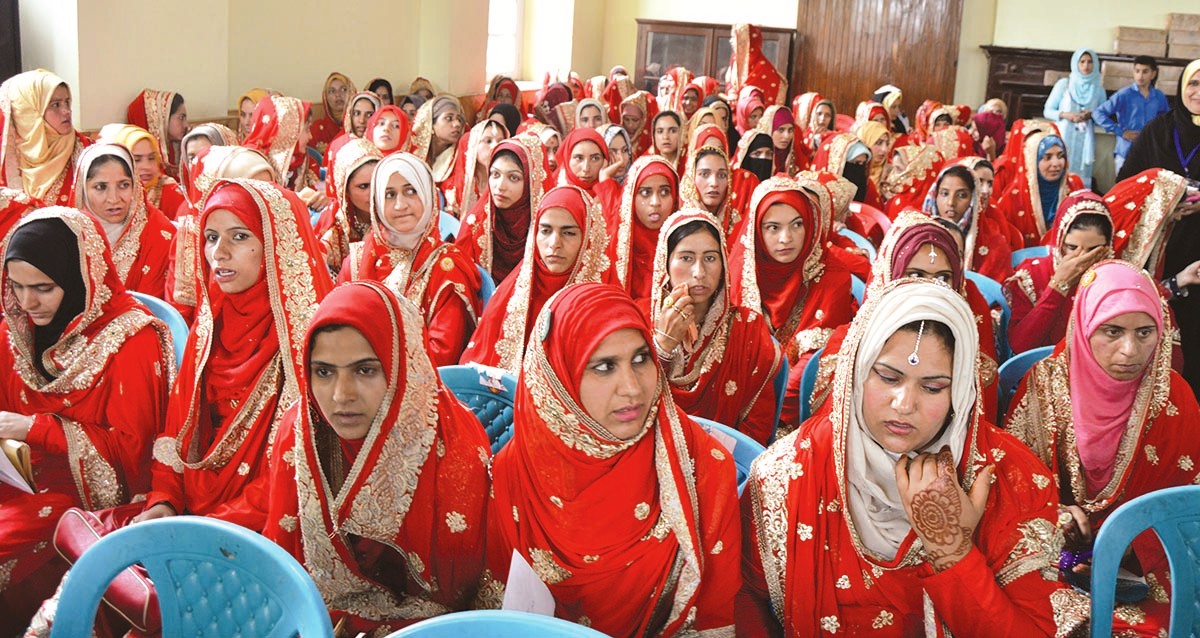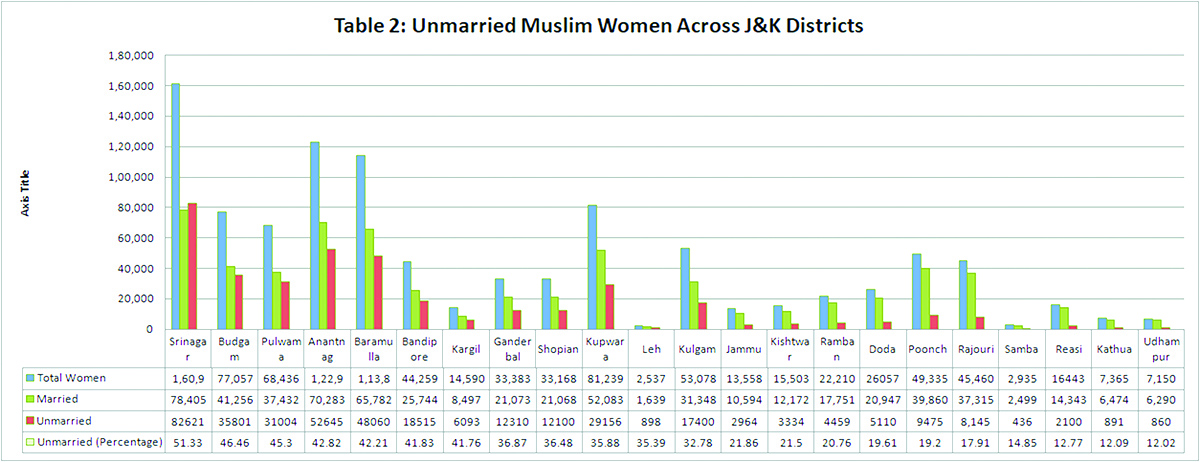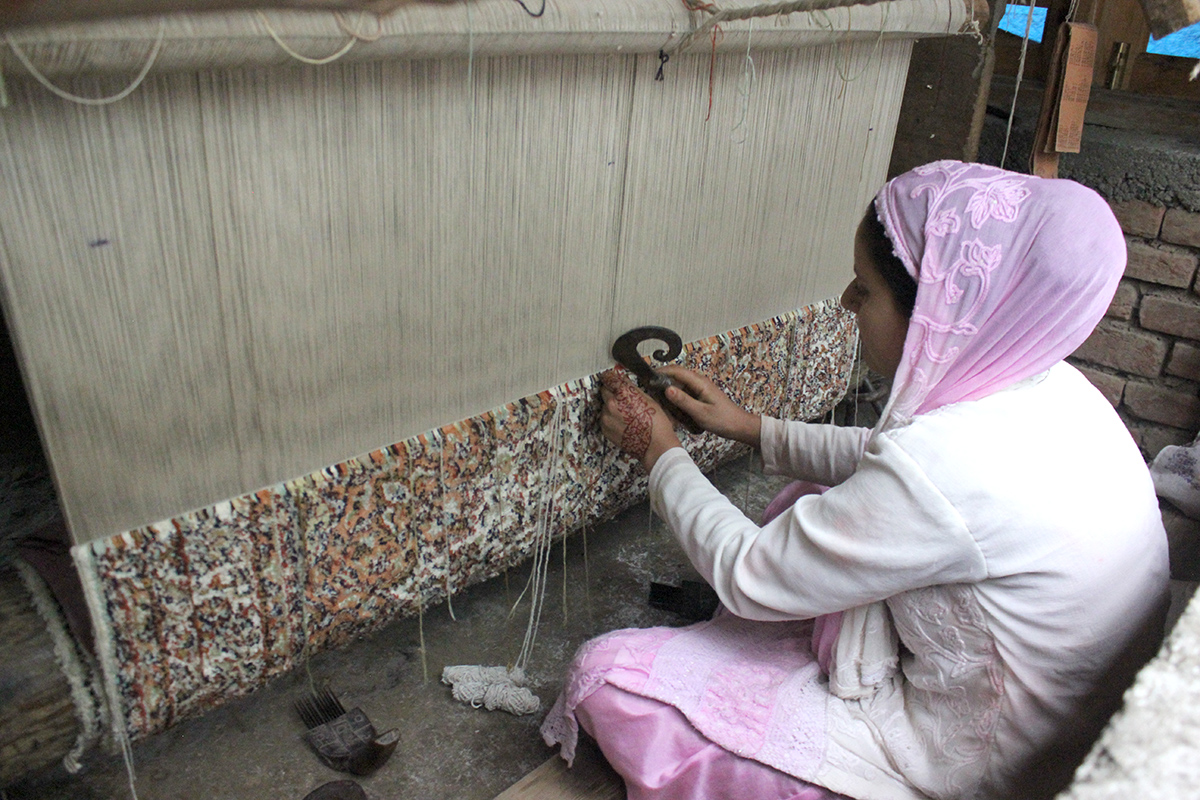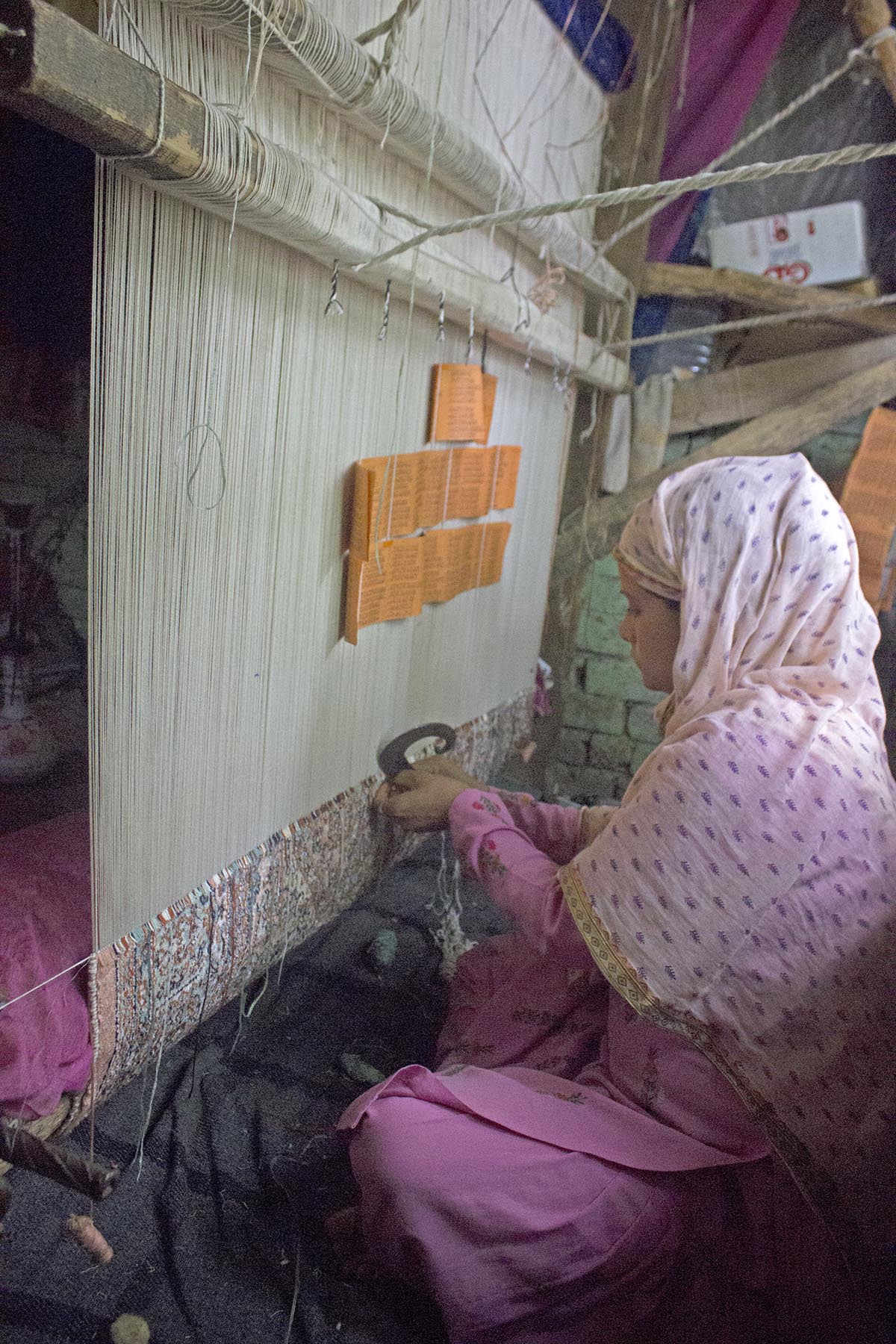When 105 brides and grooms assembled in a city club for taking marriage vows under one roof in mid-July, it was Kashmir’s first mass wedding that triggered a lot of interest. Durdana Bhat visited some of the brides and the men behind the initiative to understand the compelling situation from ground zero that convinced non local donors to chip in for help

KL Image: Mehraj Bhat
The bare skeleton of bricks and an unfurnished floor scattered with jute matting are clear pointers towards the state of well being of the inmates. The bricks painted with a lighter shade of green describe the room where the only stable and furnished object was the loom for weaving carpets. Even the flooring was sourced from used sacks. And seated near the loom with her back turned towards the window was Tabassum.
Tabassum, 23-year-old beautiful girl from Sumbal, Sonawari, 21 kms away from Srinagar, was busy with the carpet weaving, working day and night so that she can earn for her family. She is the sole earner of an underprivileged family comprising four members: a widowed mother, two younger brothers, of whom one studies in sixth standard. Her other brother dropped out of school after their father died of illness eight months back. Her two older sisters are married and settled.
In 2015, she was engaged to a man, a Pashmina weaver. But when her father died, there was no one who could help them with the daily expenses. She was supposed to get married in 2016 but with the growing expenses, she found the only way-out in taking over the loom. Tabassum has been trying her level best to earn and manage the affairs of her family, living in extreme conditions. The loom is the only source to earn for the family and she tries to save a bit for her marriage.
“I am working day and night so that I can save for my marriage,” Tabassum said in plain terms. “Right now, I cannot afford one.”
With marriages in Kashmir getting expensive, the burden seems to be getting bigger, especially for the people who cannot afford it. Though fat weddings were restricted to the urban habitations and the elite, now every marriage ceremony is expensive and elaborate. From golden jewellery to the huge dowry, the bridal gifts, the trousseau, and Wazwaan, the grand feast, the new basics of the Kashmir’s ostentatious marriages is more for the market and the society than the people who take the marriage vows.
Marriage has transformed from the occasion of celebrations to a liability generation event and a statement about social status.
The fashion of putting careers over the marriage has added a new dimension, resulting into late marriages. This is leading to the birth of an unwell generation to face the life.
As is clear from Table 1, the women prefer to defer their marriage in the prime of their youth. Census 2011 suggested that in 20-24 age group (involving conclusion of graduation and post-graduation), 63.74 percent of women were unmarried. In 25-29 age group, the unmarried were almost one-third: 32.02. Even in 30-34 age group, 11.86 percent women had not married at all.
Table 2 offers a clear situation. In cumulative three age group 20-24, 25-29 and 30-34 which makes the most productive age group for young women 20-23, a total of 13 years, the district situation tells the real story.
Districts, apparently developed and well educated, follow an urban trend in which most women in this age group wait for their marriages. In case of districts which are considered backward have a better situation as the number of unmarried women is quite less here.
Srinagar tops the number of unmarried women with 51.33 percent yet to be married. This is followed by Budgam with 46.46 percent women not married in the 20-34 age group. By and large all the Kashmir districts including the arid Ladkah desert reflect the same trend.
Unlike Kashmir, the situation of Muslim women in Jammu region is much better on this count. In most of these districts, 80 percent of women in this age group are married and settled.
But not in all the cases is the career and education a key factor that prevents marriage in the most productive age. In a number of cases, even within the urban belts, lack of resources is a key factor.

This table has sourced data of Muslim women across from Census 2011 for the age group 20-34 years of age to tabulate a trend in marriage of Muslims women across 22 districts of Jammu and Kashmir.
There are some people in the society who look beyond the obvious. In case of Tabassum, for instance, members of the Jaffri Council of Jammu and Kashmir identified her and she eventually became the part of the mass marriage where around 105 couples tied the nuptial knot in a simple function at Amar Singh Club located in Srinagar, on July 15, 2018. The ceremony, however, did not lead to instant Rukhsati. The respective families will be having small functions for that, separately.
It was first such event in the history of Kashmir. The organizers spent Rs 40,000 on each wedding including Mehar, possession paid by the groom or his father to the bride at the time of marriage.
The Council came in existence in March 2015, and is headed by Haji Musadiq Hussain who hails from Kamalkot, Uri. A retired gazetted officer, Haji completed his studies from Baramulla Degree College, Masters in Urdu from Kashmir University and another post graduation in Economics from the Maharashtra University. From last 30 years, he is living in Bagwan Porah, Lal Bazar Srinagar.
“When I retired I had a motivation to work for my people. I belong to that part of the society who are economically backward, so I wanted to work for them. I worked as a social worker before I started Jaffri Council of Jammu and Kashmir. During September floods of 2014, when my team and I launched the relief operations in Nowgam, Sonawari belt, I got an idea about this initiative.” Haji said. “Gradually, we did carry out our survey and our group realized that there were so many girls in that area that had lost their marriage stuff, which they had collected over years for marriages and it was destroyed by the devastating floods. The idea of marrying these girls gradually formed into a project and we started taking up mass marriages.”
“The concept of mass marriage was initiated by one of my friends from Gujarat, namely Asgar Bhai Kashwani, Ghulam Ali Banji Bhai (Bapu ji) and they were the people behind this concept of mass marriage,” Haji added.
One day Haji remembers he was part of a mass marriage event in Ahmadabad where 60 marriages took place. “This gave me the clear idea about how it is to be done,” he said.

Ruksana, the bride in Nowgam, is happy that she will finally settle down. In her 20s, she is an orphan who has lost her father almost eight years. Ruksana is now working at home as a carpet weaver.
Back home, Haji realized that there were around 18 girls who were supposed to marry in the same year but had lost everything to the floods. On April 8, 2015, the Council undertook to marry 38 couples from deserving categories of the society in Government Higher Secondary School, Nowgam. “In 2016, we helped 70 couples marry in a joint function in Nowgam but this time the couples hailed from different villages like Pattan, Sangrama and Nowgam. In 2017, the number rose to 75 and the function was carried out in Amar Singh club” he said. “So far, the 2018 function is the biggest. We believe next time we will have a much bigger mass marriage event.”
The group took off from Bathandi in Jammu and is a registered NGO that operates across the state. The funding of this organization is done by the people of Gujarat and Mumbai. Most of the fund members are from Gujarat and are members of Lion’s Club. There are around 10 members who fund this organization and they are mostly in business. They don’t provide cash to the organization but contribute by purchasing items which are distributed among the couples at the event.
The Council has its office in Khomanie Chowk in Bemina. The couples come and register with them at their office. Later, the members of the organization go on a survey to identify and seek proof. They visit their homes and collect the details to verify and recheck the details being submitted. In the end, they check if they deserve the help or not. They also check the age of the bride through the documents like Aadhar Card or marks card. The organization has volunteers around different districts. Haji said, in every ward there are five members and they check and verify the relevant details. After their confirmation, their block body goes on another round to re-verify the details, then tehsil body and at the end the district and the head of the organization goes on a final round. And this whole process takes around six months to complete.
In Kashmir, Haji said, they have a selfless team of 125 people including religious scholars, youth and clerics who are working round the clock for this cause. The idea behind this initiative is to tell the people that Muslims are supposed to make marriages simple and less expensive.
Another bride who took the marriage vows at the mass marriage event in Srinagar was Yasmeena, 23. Hailing from Sumbal, she completed her graduation last year and quickly she was engaged with a relative’s son in 2016.
“I have seen many girls get married very late because their parents haven’t saved enough for them,” Mohammad Yousuf, her father, said.
“Look at my condition. I couldn’t afford to marry her off right now because I am a labourer. And it’s hard to sustain in today’s world. I fear by the time I will arrange the resources, she would have passed the desirable age.”
Yousuf said the mass marriage is a good initiative. “More people should get into this so that it will be helpful for someone like us, a part of a society who no one is thinking about,” he said, insisting on every single word.
Ghulam Rasool Chakan, the Jaffri Council general secretary is also Sarpanch of Nowgam, Sonawari. He has played a key role in identifying these cases.

Tabassum is the sole earner of an underprivileged family comprising four members: a widowed mother, two younger brothers, of whom one studies in sixth standard. Her other brother dropped out of school after their father died of illness eight months back
Beneficiaries of the mass marriage event belonged to five districts. But the organizers are so keen to offer a “constituency wise” brek-up: 2 couples each from Uri, Srinagar and Ganderbal, 1 from Sagrama, 28 from Pattan, 4 from Tangmarg, 5 from Khan Sahab, 17 from Beerwah, 16 from Budgam, 5 from Zadiba, and 22 from Sonawari. “Off all of them, if you see, 30 girls are orphans so are 12 boys,” Haji said. Council gave the couples 41 items which were worth Rs 40 thousand. It didn’t have any gold item in it but had one briefcase which included the basic cosmetic products. There were no copper items. They provided them with basic kitchen items, one Almirah and it includes no cash.
The Council has volunteers from south Kashmir as well but it has not been able to sell the idea there. “The people from south Kashmir are not interested in this initiative,” Haji said. “But we hope that one day they will also be part of this process because they don’t yet know how useful this would be for them.”
At the Nikkah ceremony, the Council had asked every single groom and the bride, to bring 10 families members each to the event. They all were served a 7-course Wazwan. With the successful event at Amar Singh Club, the Council is planning another mass marriage of 30 couples after three months. “The people of Kashmir after getting to know about the mass marriage are coming forward to help these underprivileged families,” Haji insisted. “I am getting calls from different people and this will get help to more people.”
Ruksana, the bride in Nowgam, is happy that she will finally settle down. In her 20s, she is an orphan who has lost her father almost eight years. In 2016 she was engaged but her mother couldn’t afford her marriage expenses. Ruksana is now working at home as a carpet weaver and earns around Rs 70 a day.

Muhammad Yousuf, father of one of the bride showing his daughter’s belonging s.
“My mother went to Sarpanch, Ghulam Rasool Chakan to inform him about our condition and my marriage,” Rukhsana said. “He helped us through the process and we gave them the application.”
The event has made her mother happy too. “I am old now and I can’t work anymore,” her mother said. “After her father died, she learned carpet weaving in order to sustain the daily expenses. She is elder among my five children and most of the resource that is given to a bride is covered by the Jaffri Council. Now I just have to cover the expenses of her marriage feast.”
The Amar Singh Club event created a lot of interest in the society. From the newspapers to the Council offices, the queries about the next event are a continuous process. Since all the brides and the grooms who took the marriage vows were Shia Muslims, is there a possibility that even the predominant Sunni population copies the model and takes it to the next level?
“It is easy said than done,” Fayaz Ahmad Zaroo of the Humsafar Marriage Counselling Centre said. His centre is responsible for almost 30,000 modest marriages in last many years. “Marriage has certain vital basics that cannot be compromised and our system requires a lot of effort.”
Zaroo said the marriages for TV cameras are different from the marriages that will sustain the toughest tests of time. “We have a process of counselling families and then the couples and that is perhaps why we take lot of time in solemnizing a marriage,” Zaroo said. “This is important because the couple has to face challenges of life and they must be ready for that. Mass events may not suit in our case because it is a very sensitive issue and needs lot of efforts before the marriage.” He said his group is more concerned that the marriages should not end up in court rooms and police stations thus adding an avoidable cost to the children.
from Kashmir Life https://ift.tt/2Lp1QLp
via IFTTThttps://kashmirlife.net
No comments:
Post a Comment